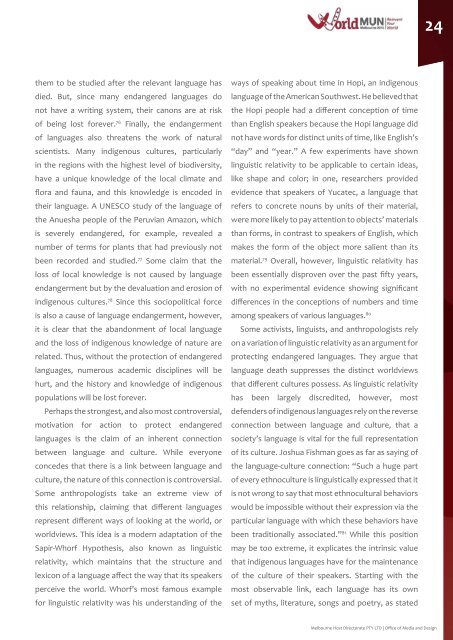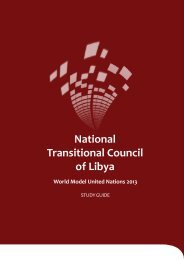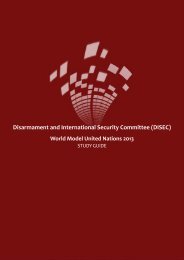Social, Humanitarian and Cultural Committee (SOCHUM)
Social, Humanitarian and Cultural Committee (SOCHUM)
Social, Humanitarian and Cultural Committee (SOCHUM)
You also want an ePaper? Increase the reach of your titles
YUMPU automatically turns print PDFs into web optimized ePapers that Google loves.
them to be studied after the relevant language has<br />
died. But, since many endangered languages do<br />
not have a writing system, their canons are at risk<br />
of being lost forever. 76 Finally, the endangerment<br />
of languages also threatens the work of natural<br />
scientists. Many indigenous cultures, particularly<br />
in the regions with the highest level of biodiversity,<br />
have a unique knowledge of the local climate <strong>and</strong><br />
flora <strong>and</strong> fauna, <strong>and</strong> this knowledge is encoded in<br />
their language. A uNeSCO study of the language of<br />
the Anuesha people of the Peruvian Amazon, which<br />
is severely endangered, for example, revealed a<br />
number of terms for plants that had previously not<br />
been recorded <strong>and</strong> studied. 77 Some claim that the<br />
loss of local knowledge is not caused by language<br />
endangerment but by the devaluation <strong>and</strong> erosion of<br />
indigenous cultures. 78 Since this sociopolitical force<br />
is also a cause of language endangerment, however,<br />
it is clear that the ab<strong>and</strong>onment of local language<br />
<strong>and</strong> the loss of indigenous knowledge of nature are<br />
related. thus, without the protection of endangered<br />
languages, numerous academic disciplines will be<br />
hurt, <strong>and</strong> the history <strong>and</strong> knowledge of indigenous<br />
populations will be lost forever.<br />
Perhaps the strongest, <strong>and</strong> also most controversial,<br />
motivation for action to protect endangered<br />
languages is the claim of an inherent connection<br />
between language <strong>and</strong> culture. While everyone<br />
concedes that there is a link between language <strong>and</strong><br />
culture, the nature of this connection is controversial.<br />
Some anthropologists take an extreme view of<br />
this relationship, claiming that different languages<br />
represent different ways of looking at the world, or<br />
worldviews. This idea is a modern adaptation of the<br />
Sapir-Whorf Hypothesis, also known as linguistic<br />
relativity, which maintains that the structure <strong>and</strong><br />
lexicon of a language affect the way that its speakers<br />
perceive the world. Whorf’s most famous example<br />
for linguistic relativity was his underst<strong>and</strong>ing of the<br />
ways of speaking about time in Hopi, an indigenous<br />
language of the American Southwest. He believed that<br />
the Hopi people had a different conception of time<br />
than English speakers because the Hopi language did<br />
not have words for distinct units of time, like English’s<br />
“day” <strong>and</strong> “year.” A few experiments have shown<br />
linguistic relativity to be applicable to certain ideas,<br />
like shape <strong>and</strong> color; in one, researchers provided<br />
evidence that speakers of Yucatec, a language that<br />
refers to concrete nouns by units of their material,<br />
were more likely to pay attention to objects’ materials<br />
than forms, in contrast to speakers of English, which<br />
makes the form of the object more salient than its<br />
material. 79 Overall, however, linguistic relativity has<br />
been essentially disproven over the past fifty years,<br />
with no experimental evidence showing significant<br />
differences in the conceptions of numbers <strong>and</strong> time<br />
among speakers of various languages. 80<br />
Some activists, linguists, <strong>and</strong> anthropologists rely<br />
on a variation of linguistic relativity as an argument for<br />
protecting endangered languages. they argue that<br />
language death suppresses the distinct worldviews<br />
that different cultures possess. As linguistic relativity<br />
has been largely discredited, however, most<br />
defenders of indigenous languages rely on the reverse<br />
connection between language <strong>and</strong> culture, that a<br />
society’s language is vital for the full representation<br />
of its culture. Joshua Fishman goes as far as saying of<br />
the language-culture connection: “Such a huge part<br />
of every ethnoculture is linguistically expressed that it<br />
is not wrong to say that most ethnocultural behaviors<br />
would be impossible without their expression via the<br />
particular language with which these behaviors have<br />
been traditionally associated.” 81 While this position<br />
may be too extreme, it explicates the intrinsic value<br />
that indigenous languages have for the maintenance<br />
of the culture of their speakers. Starting with the<br />
most observable link, each language has its own<br />
set of myths, literature, songs <strong>and</strong> poetry, as stated<br />
24<br />
Melbourne Host Directorate PTY LTD | Office of Media <strong>and</strong> Design

















